21 min read
Sales planning is a fundamental component of sound selling. After all, you can’t structure an effective sales effort if you don’t have, well, structure.
Free Download: Sales Plan Template
In my experience, everyone — from the top to the bottom of a sales org — benefits from having solid, actionable, thoughtfully-organized sales plans.
But putting together a sales plan isn’t always straightforward. It can be kind of complicated; involves tons of steps. But there is good news: you don’t have to make a sales plan with zero help. To guide you through this partly-intense process, I’ve assembled this detailed blog post that reviews everything you should know about sales planning (and will ensure your next sales plan is practical, produces results that you want to see, and detail-oriented).
Table of Contents:
- What is a sales plan?
- Sales Planning Process
- Importance of the Sales Planning Process
- What goes in a sales plan template?
- How to Write a Sales Plan
- How to Write a Sales Plan
- Tips for Creating an Effective Sales Plan
- Types of Sales Plans
- Strategic Sales Plan Examples
- Create a Sales Plan That Grows With Your Business
What is a sales plan?
A sales plan outlines your objectives, high-level tactics, target audience, and potential obstacles. It’s like a traditional business plan that focuses on your sales strategy. A business plan lays out your goals — a sales plan describes precisely how you’ll make those happen.
Sales plans often include information about the business’s target customers, revenue goals, team structure, and the strategies and resources necessary for achieving its targets.
What are the goals of an effective sales plan?
The purpose of your company’s sales plan is to:
- Communicate company goals and objectives
- Provide strategic direction
- Outline roles and responsibilities
- Monitor your sales team’s progress
1. Communicate your company’s goals and objectives.
Goals and objectives are the lifeblood of successful sales efforts. You can’t know what you’re working for or whether you‘ve achieved anything meaningful if you don’t have them in place.
Your sales reps need a solid sense of what’s expected of them. You can’t go to your team and just say, “Sell.” In my experience, you have to establish clear, practical, and ambitious benchmarks.
And if — or more likely when — those goals change over time, you need to regularly communicate those shifts and the strategic adjustments that come with them to your team.
2. Provide strategic direction.
Your sales strategy keeps your sales process productive. It offers actionable steps your reps can take to deliver on your vision and realize the goals you set. So naturally, you need to communicate it effectively. A sales plan offers a solid resource for that.
For instance, your sales org might notice your SDRs are posting lackluster cold call conversion rates. In turn, they should focus primarily on email outreach. Or you could experiment with new sales messaging on calls. Or you could test a multi-channel approach by incorporating social media outreach and personalized video sales letters.
There’s many approaches to take, but here’s the core of my advice: Don’t force it. Do what feels most organic for you and your sales team. Regardless of how you want to approach the situation, a thoughtfully structured sales plan gives both you and your reps a high-level perspective that would inform more cohesive, authentic team efforts.
3. Outline roles and responsibilities.
An effective sales org is a machine, where each part has a specific function that serves a specific purpose that needs to be executed in a specific fashion. Everyone who comprises that org needs to have a clear understanding of how they specifically play into the company’s broader sales strategy.
In my opinion, outlining roles and responsibilities while sales planning lends itself to more efficient task delegation, overlap reduction, and increased accountability. All of which amount to more streamlined, successful sales efforts.
4. Monitor your sales team’s progress.
Sales planning sets the framework for gauging how well your team delivers on your sales strategy. It informs the benchmarks and milestones reps use to see how their performance compares to your goals and expectations.
I’ve also found it gives sales leadership a holistic view of how well a sales org is functioning, giving them the necessary perspective to understand whether they have the right people and tools to thrive.
Sales Planning Process
Sales planning isn’t (and shouldn’t) be limited to the actual sales plan document it produces. If that document has any substance or practical value, it should be the byproduct of a thorough, well-informed, high-level strategy.
In my experience, there are some key steps you need to cover when planning sales. These include:
- Gathering sales data and searching for trends
- Defining your objectives
- Determining metrics for success
- Assessing the current situation
- Starting sales forecasting
- Identifying gaps
- Ideating new initiatives
- Involving stakeholders
- Outlining action items
When putting this list together, I tapped Zach Drollinger, Senior Director of Sales at Coursedog, to ensure the examples below were sound and accurate. (I won’t lie: The expertise Zach offered took what I already knew from well-informed to exceptionally well-rounded. He really knows his stuff.)
Take a look through the step-by-step sales planning guide I assembled below:
Step 1: Gather sales data and search for trends.
Your company needs to look to the past to plan for the present and future. Ask yourself questions like:
- What did sales look like during the previous year? What about the last five years?
- Which strategies and tactics drove the most revenue, and which ones fell flat?
- How have market conditions or customer behaviors shifted over time, and what impact has that had on sales?
Using this information helps you identify trends in your industry. While it’s not entirely foolproof, it does help establish a foundation for your sales planning process; that’s the stability we need to get started.
How to Collect Sales Data
Let’s say I’m a new sales director for an edtech company that sells curriculum planning software to higher education institutions. My vertical is community colleges, and my territory is the East Coast.
Once I assume this new role, I’ll want to gather as much context as possible about my vertical and how my company has approached it historically. I’ll pull information about how we’ve sold to this vertical:
- How many new businesses have we closed within it in the past five years?
- How does that compare to how we perform with other kinds of institutions?
- Are we seeing significant churn from these customers?
I’ll also want context about the general needs, interests, and pain points of the institutions I’m selling to. I’ll also look for insights into degree velocity, staff retention, and enrollment.
The idea is to have a comprehensive perspective on my sales process — you should walk away from your data exploration efforts with a thorough understanding of where I stand and what my prospects deal with.
Step 2: Define your objectives.
How do you know your business is doing well if you have no goals and objectives? Once you’ve defined them, you can move forward with executing them.
How to Determine Sales Objectives
Extending the example from the previous step, I’d leverage the context I gathered through the research I conducted about my and my prospect’s circumstances. I’ll start setting both broader goals and more granular operational objectives.
For instance, I can set a goal of increasing sales revenue from my vertical. From there, I’ll start assembling the specific objectives that facilitate that process. Think: connecting with administrators from at least 30 community colleges, booking demos with at least 10 schools, and successfully closing at least five institutions.
Obviously, those steps represent a super streamlined (and unrealistically straightforward) sales process, but you get the idea.
Additionally, I’ll set a concrete goal, supplemented by SMART objectives, to serve as a solid reference point for my org’s efforts as the sales process progresses.
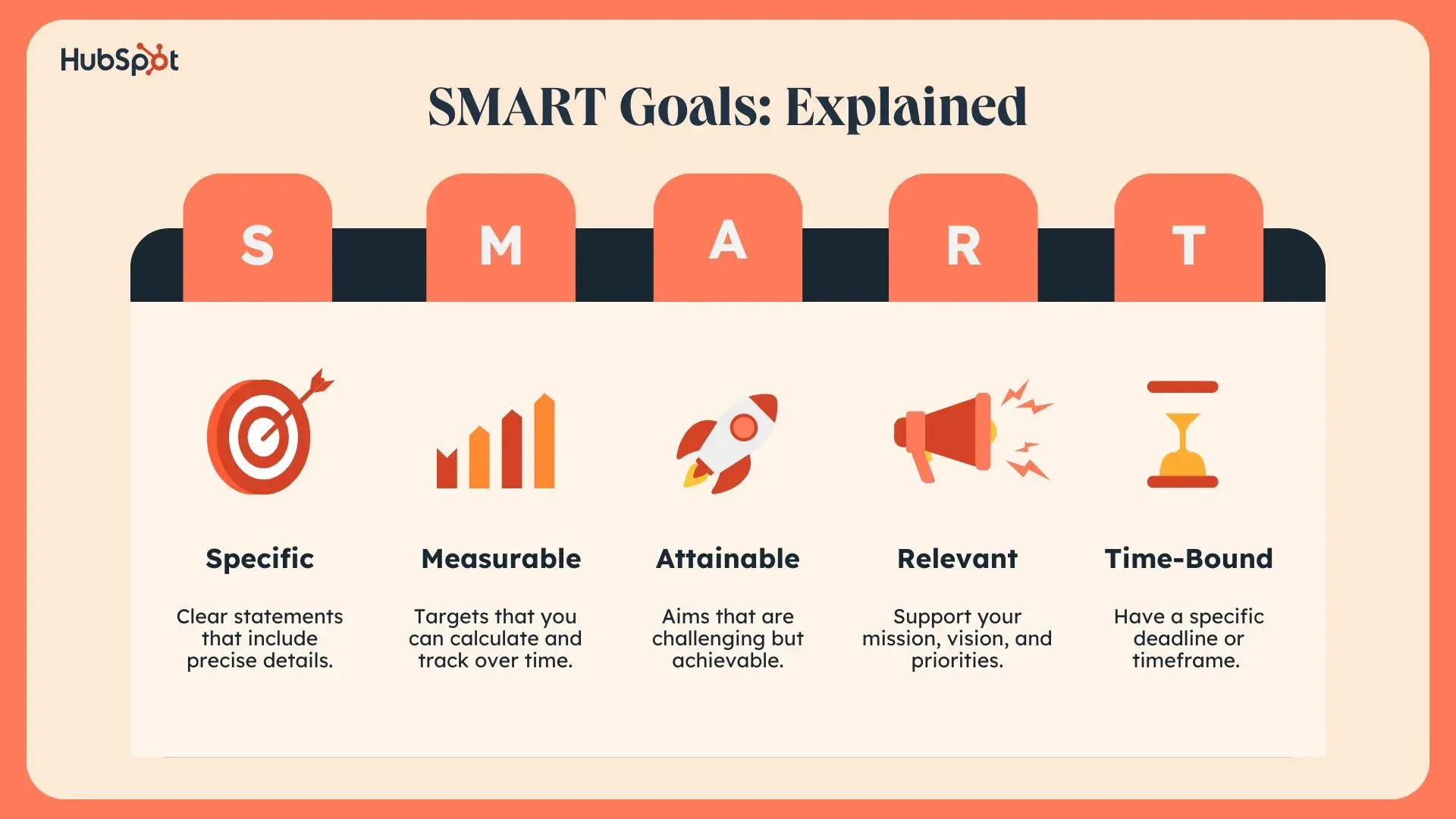
Step 3: Determine metrics for success.
Yes, every business is different. However, we can all agree that every business needs metrics and key performance indicators (KPIs) for success.
What metrics will you use to determine whether your business is successful? KPIs differ based on your medium, but standard metrics are gross profit margins, return on investment (ROI), daily web traffic users, conversion rate, and more.
Sales Rep KPIs vs. Sales Manager KPIs
For sales reps, KPIs zero in on metrics that shape their daily grind and productivity. Like these:
- Number of calls made: This one keeps reps on their toes, ensuring they’re hustling and maintaining a high level of outreach
- Conversion rate: Tracks how many prospects become customers, revealing the power of their pitches
- Average deal size: Monitors the average revenue per deal, pushing reps to close bigger, better sales
- Sales cycle length: Helps reps streamline their processes and identify ways to speed things up
For sales managers, KPIs take a broader, more strategic view of team performance. Key metrics include:
- Total revenue: Measures the team’s overall revenue, monitoring progress towards sales targets
- Pipeline value: Shows the total value of deals in the pipeline, giving insight into future revenue
- Win rate: Indicates the percentage of deals closed successfully, highlighting strengths and areas for improvement in the sales process
- Employee retention rate: Keeps track of team stability and satisfaction — crucial for long-term success
- Training and development progress: Monitors the effectiveness of training programs, ensuring continuous skill development
How to Identify Sales Metrics
I kind of covered this step in the previous example, but it still warrants a bit more elaboration.
The “M” in SMART goals (“measurable”) is there for a reason. You can’t tell if your efforts were successful if you don’t know what “successful” actually means.
In my edtech sales example, I’m assuming ownership of an existing vertical and getting more out of it. So, it’s fair to assume that sales growth rate — the increase or decrease of sales revenue in a given period, typically expressed as a percentage — would be an effective way to gauge success.
I can also structure my goals and objectives around a sales growth rate of 20% Y/Y within my vertical. I’ll make sure my org is familiar with that figure and offer some context about what it would take to reach it — namely, how many institutions we would need to close and retain.
Step 4: Assess the current situation.
How is your business fairing right now? This information is relevant to determining how your current situation matches the goals and objectives you set during Step 2. What are your roadblocks? What are your strengths?
Create a list of the obstacles hindering your success. Identify the assets you can use as an advantage. These factors will guide you as you build your sales plan.
How to Evaluate Current Business Standing
Continuing the edtech example, I’ll use the historical context I gathered and the objectives I set to frame how I look at my current circumstances.
For instance, consider my goal of increasing revenue by 20% Y/Y. In that case, I’d look at the company’s retention figures. Ideally, this would give me a sense of whether that needs to be a significant area of focus.
I‘d also try pinpointing trends in the colleges we’ve already closed. Are there any pain points we consistently sell on? I’ll take a closer look at how we demo to see if we might be glossing over key elements of our value proposition. Maybe I can use conversation intelligence to get a better sense of how reps are handling their calls.
Ultimately, I would identify why we’re performing the way we are. These inefficiencies might result from our current strategy and how my team can best set ourselves up to sell as effectively as possible.
Step 5: Start sales forecasting.
Sales forecasting is an in-depth report that predicts what a salesperson, team, or company will sell weekly, monthly, quarterly, or annually. While it’s finicky, it helps your company make better decisions when hiring, budgeting, prospecting, and setting goals.
After the COVID-19 pandemic, economics have become less predictable. StrActGro owner Claire Fenton states, “Many economic forecasters won’t predict beyond three months at a time.” This makes sales forecasting difficult.
Luckily, there are tools at your disposal to create accurate sales forecasts.
For sales managers, I find HubSpot’s forecasting tool invaluable for tracking team progress toward goals. It forecasts revenue based on deal stages and their likelihood of closing. Plus, you can set up forecast categories to group deals and adjust them based on your team’s insights.
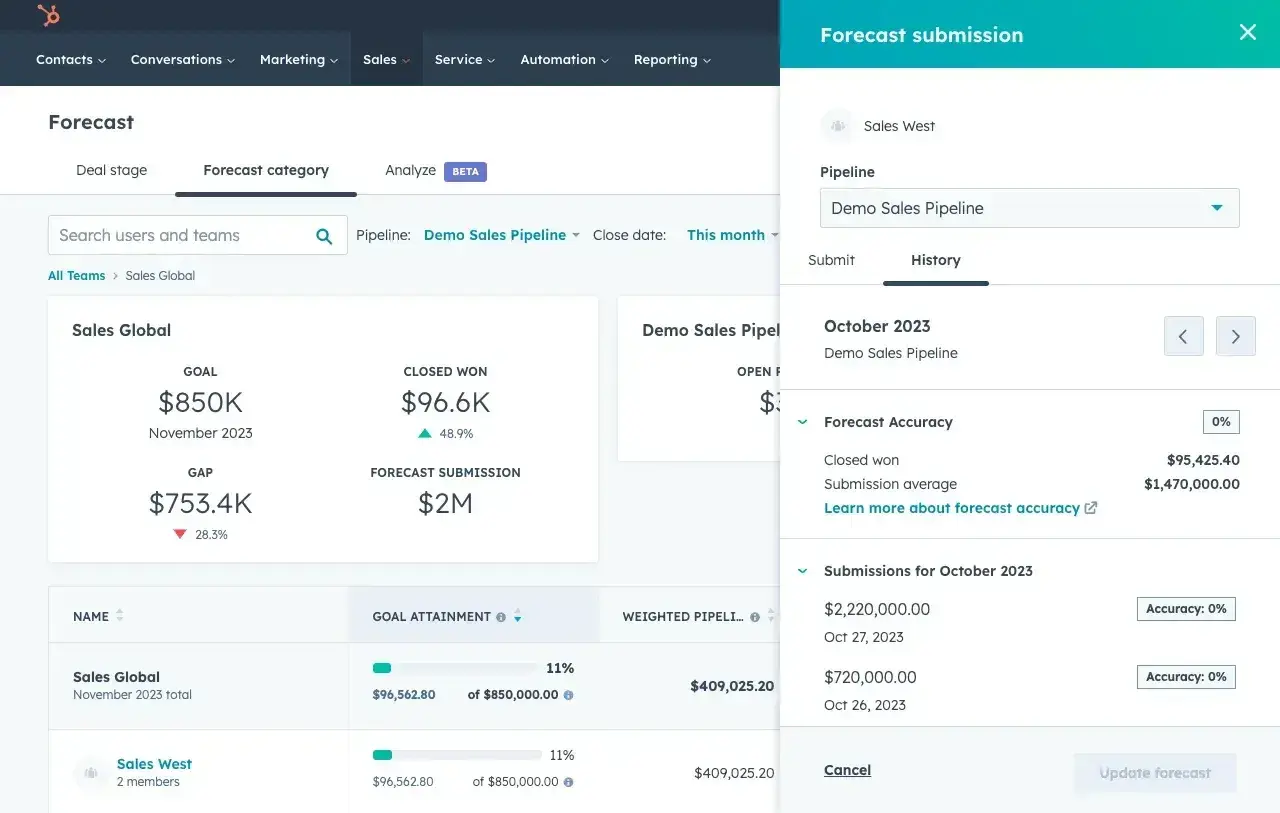
How to Forecast Sales
Following our edtech example, I’d approach this step by estimating how my sales org might perform in the allotted time window with the specific vertical we’re pursuing.
The method I choose will depend on several factors, including the number of concrete opportunities, available historical data, reps’ performance, and our insights about potential customers.
Let’s say I consider those factors and decide to run a multivariable analysis. Here’s how I’d go about it:
First, I’d take stock of the opportunities my reps have lined up. Then, I’d examine the reps working on those deals, their typical win rates, and their time to close. For example, if a rep works with a large institution and has a 50% chance of closing within the timeframe, I’d attribute 50% of the potential deal size to our forecast.
By repeating this process for all opportunities, I’ll get a solid sense of the expected revenue within the allotted window.
Step 6: Identify gaps.
When identifying gaps in your business, consider your company’s current and future needs. First, identify the skills your employees need to reach your goal. Second, evaluate the skills of your current employees.
Once you have this information, train employees or hire new ones to fill the gaps.
How to Identify Selling Gaps
In our edtech example, let’s say my forecast yielded results that didn’t align with what we needed to achieve our goals. To tackle this, I’d take a holistic look at our process, operations, and resources to find inefficiencies or areas for improvement.
Say I discover that our sales content and marketing collateral are outdated, with case studies missing our product’s newest and most relevant features. Meanwhile, our reps are booking demos, but the demos aren’t converting because of a lack of training and inconsistent messaging.
Finally, I notice that misalignment with marketing leads to prospects expecting unrealistic outcomes that our sales team can‘t deliver. Once I’ve identified those gaps, I’ll focus on ways to remedy those issues and improve those elements.
Step 7: Ideate new initiatives.
Many industry trends are cyclical. They phase in and out of “style.” As you build your sales plan, consider initiatives you might have overlooked.
Has your business relied solely on word-of-mouth and social media marketing? Now might be the time to try webinars or special promotions.
How to Ideate New Sales Initiatives
In our ongoing edtech example, I would ideate initiatives based on the gaps I identified in the previous step. This might involve updating our sales content and marketing materials to make them top-notch.
Next, I’ll introduce new training programs to help our team excel at conducting effective demos. Finally, I’ll start working on a plan with marketing to ensure our messaging is aligned with theirs — so our prospects have realistic and clear expectations.
The key is to turn gaps into concrete, actionable plans. Just saying, “We’re going to be better at demos,” isn’t a plan — it’s a sentiment, and sentiments don’t translate into sales.
Step 8: Involve stakeholders.
Stakeholders are individuals, groups, or organizations with a vested interest in your company. They are typically investors, employees, or customers and often have deciding power in your business.
Towards the end of your sales planning process, involve stakeholders from departments that affect your outcomes, such as marketing and product. This will result in an efficient, more holistic, more actionable sales planning process.
How to Involve Stakeholders
Once I’ve pinpointed the key issues blocking my edtech startup’s sales team, it’s time to start recruiting the right people.
First, I’ll reach out to stakeholders handling our sales content and marketing collateral. They’re the ones who can create new, relevant case studies and whitepapers for the institutions we work with.
Next, I’ll go to middle management. Depending on the situation, I might offer more direction for coaching on demos. Or bring in a third-party training service for professional insights.
Finally, I’ll contact marketing leadership to clarify our message. Aligning the benefits and outcomes we highlight during pitches ensures that the schools we target have realistic expectations of our product.
Step 9: Outline action items.
Once you’ve implemented this strategy to create your sales planning process, the final step is outlining your action items.
Using your company’s capacity and quota numbers, build a list of action steps that take you through the sales process. Think: writing a sales call script, identifying industry competitors, and strategizing new incentives or perks.
How to Create a Sales Action Plan
In our edtech example, some key action items might be:
- Revamp our prospecting strategy via more involved coaching and re-tooled sales messaging
- Revamp administrator and college dean buyer personas
- Conduct new training on demoing our software
- See our new prospecting strategy from ideation to execution
- Align with our sales enablement stakeholders for new, more relevant case studies and whitepapers
Obviously, this list isn’t exhaustive — but those are still the kinds of steps we would need to clarify and take to structure a more effective high-level strategy to produce different (ideally much better) results than we’ve been seeing.
One thing to keep in mind is that sales planning shouldn’t end with creating the document.
I recommend repeating this process yearly to maintain your organization’s sales excellence. I would also advise you to set up a Standard Operating Procedure (SOP) around your entire sales planning process to spare yourself the headache of starting completely from scratch each year and ensure consistency across your organization. Check HubSpot’s free SOP template to see how you can get started.
Importance of the Sales Planning Process
Sales strategies based more on intuition than data might work sometimes, but they will always lack consistency and scalability. On the other hand, a clear sales planning process aligns the entire team toward common goals, ensuring effective and more cohesive collaboration.
I remember when my client’s sales numbers were consistently below target. Unsurprisingly, team morale was low.
After analyzing their processes, the sales manager realized the company lacked a coherent sales plan. So, they introduced a detailed sales planning process that included:
- Setting realistic targets
- Identifying key prospects
- Implementing regular performance reviews
Within six months, the client saw a 27% increase in sales. Moreover, their team was more motivated and engaged than ever before.
This could happen for you (and your sales team), too. Take a moment to review the key benefits of having a sales planning process to drive growth and implement efficiency:
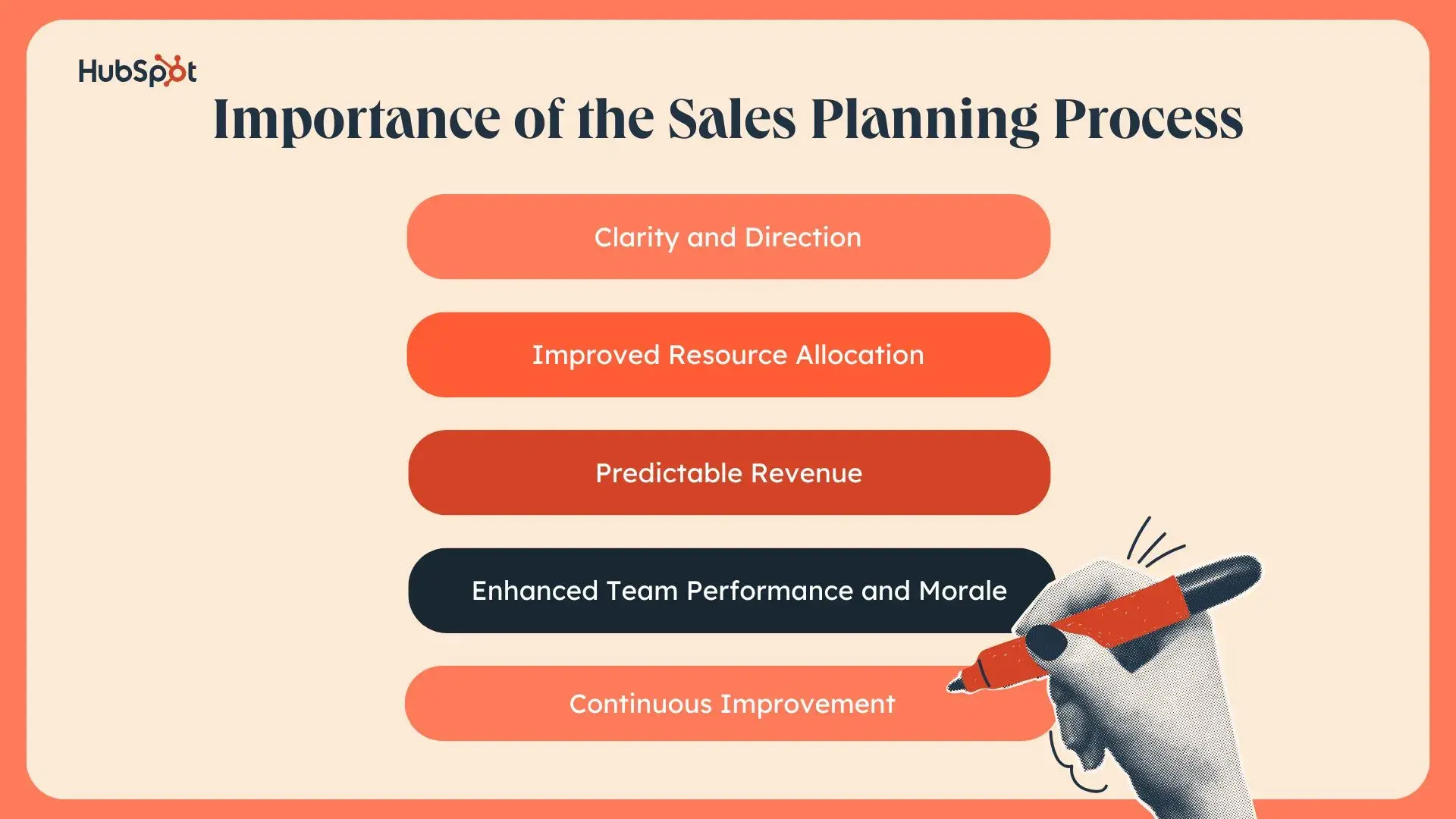
1. Clarity and Direction
In my experience, implementing a detailed sales plan changes everything. You‘ll have a clear path to follow, with defined goals and milestones that align everyone on your team. Without a clear plan, prioritizing leads is difficult, and you’ll often find yourself scrambling at the end of every month to meet targets.
2. Improved Resource Allocation
You can identify where to allocate your resources most effectively, whether it’s personnel, budget, or time. The same client I mentioned before used to spread their resources thinly across numerous prospects. Once they started planning, they knew better — they focused on high-potential leads, leading to better conversion rates and increased revenue.
3. Predictable Revenue
One of the most significant benefits of sales planning is predictability. With a predictable revenue stream, I can budget better and invest strategically in growth areas. In fact, according to a Logility report, companies that do effective sales planning see a 31% improvement in forecast accuracy.
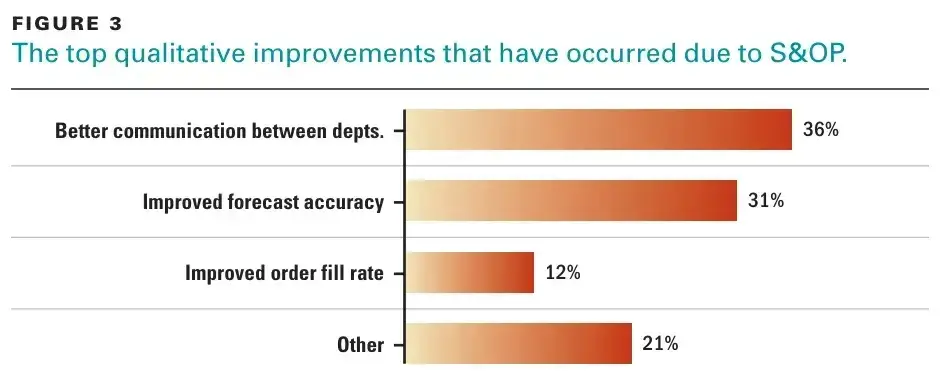
[alt text] a screenshot of a survey figure from a consumer goods study on sales operations and planning
4. Enhanced Team Performance and Morale
As I mentioned, my client’s sales team also struggled with low morale due to unclear targets and objectives. When they introduced a comprehensive sales plan to the equation, they could define clear goals and milestones.
This improved team morale and nurtured a sense of purpose and motivation, which boosted performance and job satisfaction.
5. Continuous Improvement
Sales planning establishes benchmarks and performance metrics are essential for accountability and continuous improvement within the team.
I always champion monthly review meetings where teams can regularly assess progress against the established plan. You can identify areas for improvement, recognize high performers, and address issues promptly.
Now that you’re committed to the sales planning process, I’ll show you how to approach into the written component of sales planning.
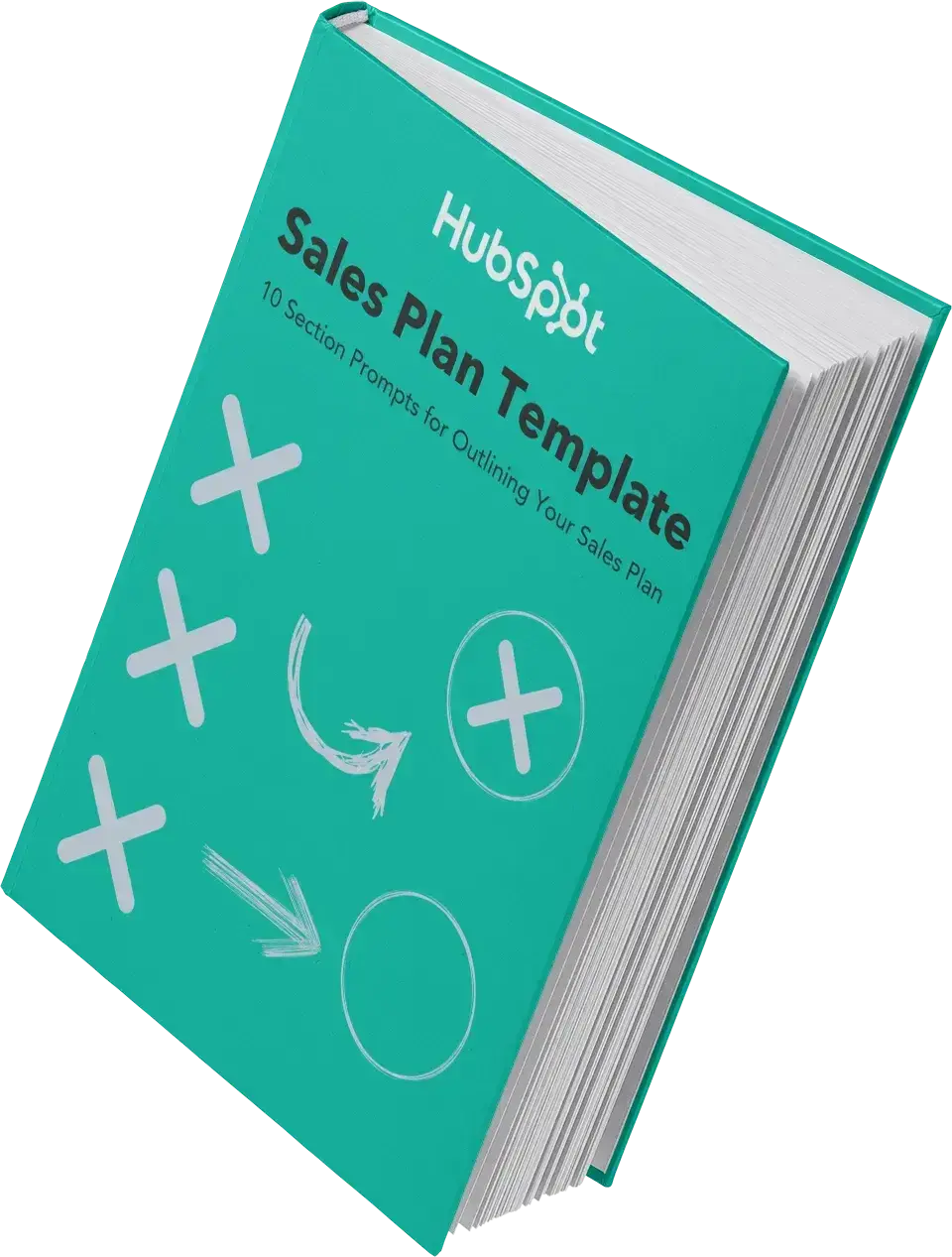
Ready to write your own plan? Download HubSpot’s Free Sales Plan Template.
What goes in a sales plan template?
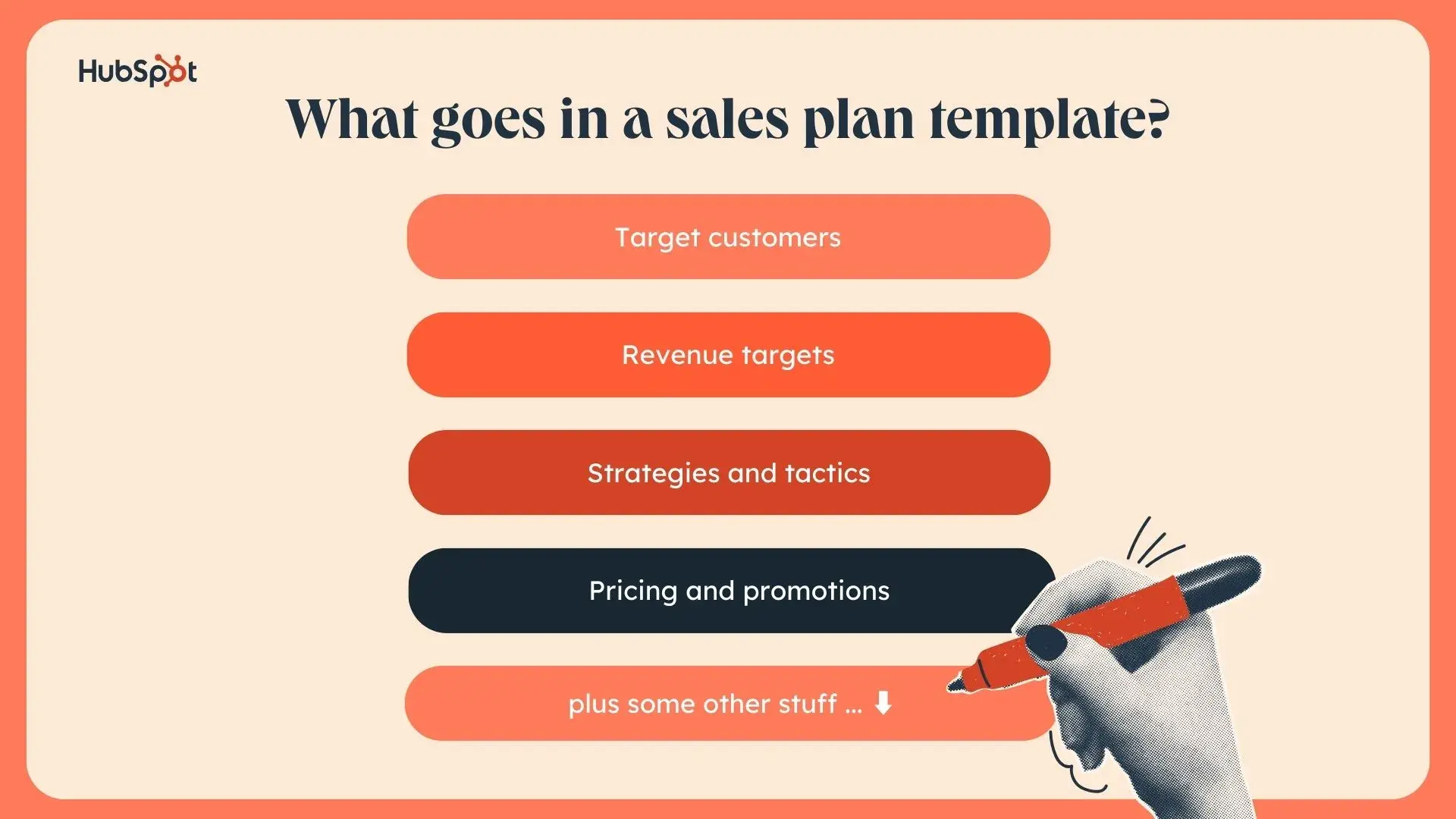
A typical sales plan includes the following sections:
- Target customers
- Revenue targets
- Strategies and tactics
- Pricing and promotions
- Deadlines and DRIs
- Team structure
- Resources
- Market conditions
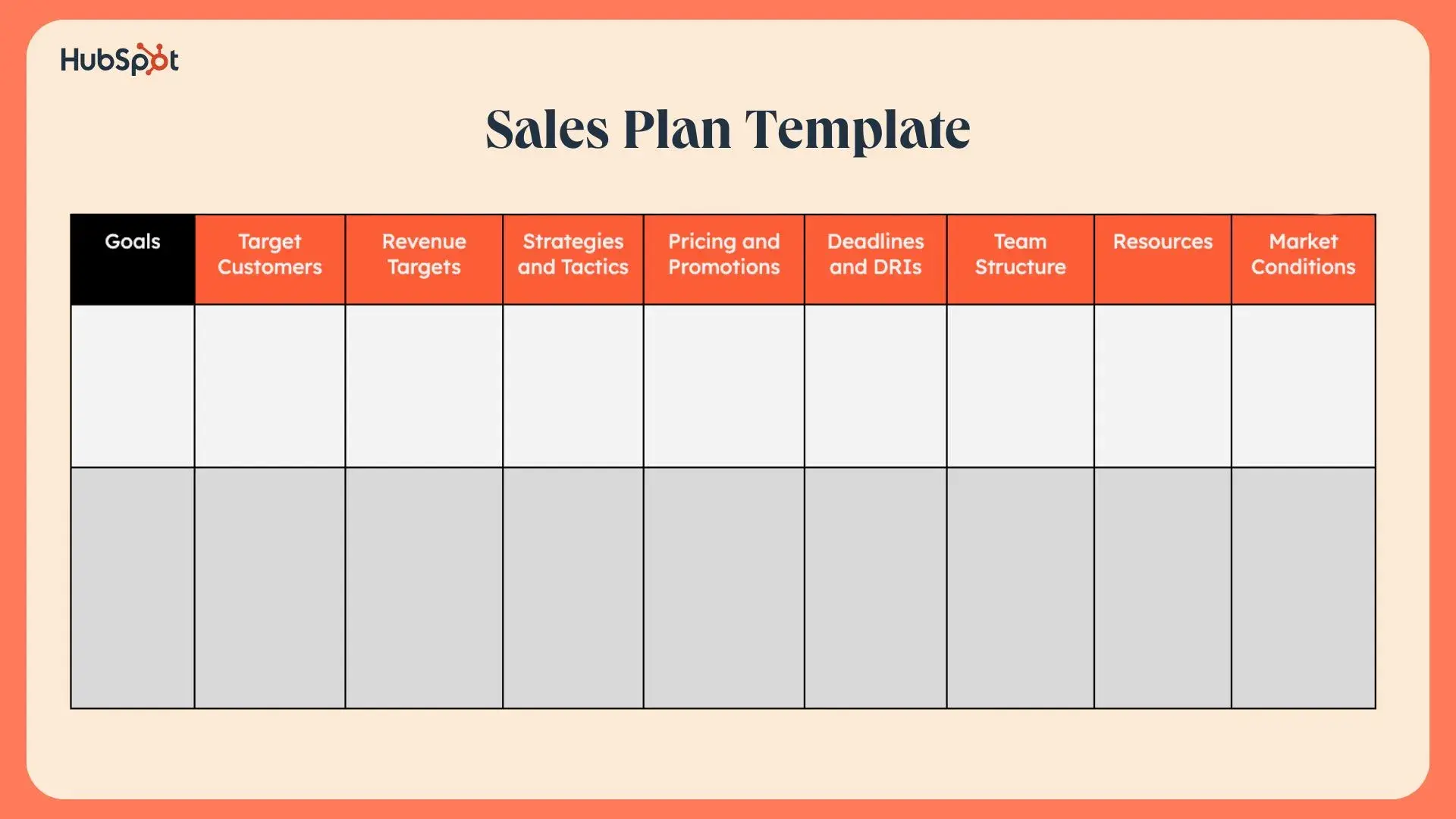
1. Target Customers
Your target customers are the people your company wants to serve with its products and services. They’re the ones most likely to buy from you. You identify them by breaking down your target market into smaller, more focused groups based on geography, behavior, demography, and more.
There are a few angles to approach this from; here’s how I recommend doing it:
- Segmenting customers by industry and business size. Not all companies have the exact needs. Identifying your ideal customer based on industry and company size allows you to tailor messaging effectively. For example, a SaaS company might target mid-sized e-commerce businesses needing cost-effective fulfillment and shipping optimization while offering an enterprise-tier solution for large retailers with more complex operations.
- Segmenting customers by pain points and buying motivations. Every customer has unique challenges that drive them to seek unique solutions. Understanding these pain points allows you to position your product as the best answer to their problem. For example, a logistics provider targeting e-commerce businesses should highlight solutions for reducing shipping delays and optimizing last-mile delivery, which are major pain points in the industry.
- Segmenting customers by geographical considerations. Different regions have different consumer behaviors, regulatory requirements, and logistical constraints. Your strategy should be customized for these variations. For example, a cybersecurity firm may target U.S. financial institutions with compliance-driven security solutions while offering more cost-effective, scalable options for emerging markets in international territories.
How to Identify Your Target Audience
Let’s continue with our edtech example for this section, too.
As mentioned, my territory is the East Coast, and my vertical is community colleges — so my target market is community colleges on the East Coast.
That’s clear, but my target customers aren’t just the institutions. I need to know the specific contact points when selling to these colleges.
Modern buying decisions often involve multiple stakeholders, especially in large organizations like community colleges. So, my understanding of target customers needs to be more detailed than just “representatives from the school.”
When selling curriculum scheduling software, I’d likely deal with administrators and deans — two personas with different responsibilities. I need to understand both types of customers for effective sales planning.
I’d also consider factors like their daily tasks, the pain points from those tasks, how my software could help, and why their lives would be easier with my product.
2. Revenue Targets
Target revenue is how much money your company aims to bring in during a given time. You can set them up a few different ways. Here are a few options for setting realistic revenue targets within your sales plan:








